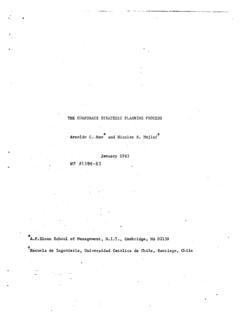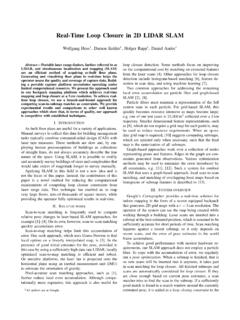Transcription of SLAM for Dummies
1 1 slam for Dummies A Tutorial Approach to Simultaneous localization and mapping By the Dummies S ren Riisgaard and Morten Rufus Blas 2 1. Table of contents 1. TABLE OF 2. INTRODUCTION ..4 3. ABOUT slam ..6 4. THE THE THE RANGE MEASUREMENT 5. THE slam PROCESS ..10 6. LASER DATA ..14 7. ODOMETRY DATA ..15 8. LANDMARKS ..16 9. LANDMARK EXTRACTION ..19 SPIKE LANDM MULTIPLE 10. DATA ASSOCIATION ..25 11. THE EKF ..28 OVERVIEW OF THE THE The system state: X ..29 The covariance matrix: The Kalman gain: The Jacobian of the measurement model: H ..31 The Jacobian of the prediction model: A ..33 The slam specific Jacobians: Jxr and The process noise: Q and The measurement noise: R and V ..35 STEP 1: UPDATE CURRENT STATE USING THE ODOMETRY STEP 2: UPDATE STATE FROM RE-OBSERVED STEP 3: ADD NEW LANDMARKS TO THE CURRENT 12.
2 FINAL REMARKS ..41 3 13. REFERENCES: ..42 14. APPENDIX A: COORDINATE CONVERSION ..43 15. APPENDIX B: SICK LMS 200 INTERFACE 16. APPENDIX C: ER1 INTERFACE CODE ..52 17. APPENDIX D: LANDMARK EXTRACTION CODE ..82 4 2. Introduction The goal of this document is to give a tutorial introduction to the field of slam (Simultaneous localization And mapping ) for mobile robots. There are numerous papers on the subject but for someone new in the field it will require many hours of research to understand many of the intricacies involved in implementing slam . The hope is thus to present the subject in a clear and concise manner while keeping the prerequisites required to understand the document to a minimum. It should actually be possible to sit down and implement basic slam after having read this paper.
3 slam can be implemented in many ways. First of all there is a huge amount of different hardware that can be used. Secondly slam is more like a concept than a single algorithm. There are many steps involved in slam and these different steps can be implemented using a number of different algorithms. In most cases we explain a single approach to these different steps but hint at other possible ways to do them for the purpose of further reading. The motivation behind writing this paper is primarily to help ourselves understand slam better. One will always get a better knowledge of a subject by teaching it. Second of all most of the existing slam papers are very theoretic and primarily focus on innovations in small areas of slam , which of course is their purpose. The purpose of this paper is to be very practical and focus on a simple, basic slam algorithm that can be used as a starting point to get to know slam better.
4 For people with some background knowledge in slam we here present a complete solution for slam using EKF (Extended Kalman Filter). By complete we do not mean perfect. What we mean is that we cover all the basic steps required to get an implementation up and running. It must also be noted that slam as such has not been completely solved and there is still considerable research going on in the field. To make it easy to get started all code is provided, so it is basically just a matter of downloading it, compiling it, plugging in the hardware (SICK laser scanner, ER1 robot) and executing the application; Plug-and-Play. We have used Microsoft Visual 5 C# and the code will compile in the .Net Framework v. Most of the code is very straightforward and can be read almost as pseudo-code, so porting to other languages or platforms should be easy.
5 6 3. About slam The term slam is as stated an acronym for Simultaneous localization And mapping . It was originally developed by Hugh Durrant-Whyte and John J. Leonard [7] based on earlier work by Smith, Self and Cheeseman [6]. Durrant-Whyte and Leonard originally termed it SMAL but it was later changed to give a better impact. slam is concerned with the problem of building a map of an unknown environment by a mobile robot while at the same time navigating the environment using the map. slam consists of multiple parts; Landmark extraction, data association, state estimation, state update and landmark update. There are many ways to solve each of the smaller parts. We will be showing examples for each part. This also means that some of the parts can be replaced by a new way of doing this. As an example we will solve the landmark extraction problem in two different ways and comment on the methods.
6 The idea is that you can use our implementation and extend it by using your own novel approach to these algorithms. We have decided to focus on a mobile robot in an indoor environment. You may choose to change some of these algorithms so that it can be for example used in a different environment. slam is applicable for both 2D and 3D motion. We will only be considering 2D motion. It is helpful if the reader is already familiar with the general concepts of slam on an introductory level, through a university level course on the subject. There are lots of great introductions to this field of research including [6][4]. Also it is helpful to know a little about the Extended Kalman Filter (EKF); sources of introduction are [3][5]. Background information is always helpful as it will allow you to more easily understand this tutorial but it is not strictly required to comprehend all of it.
7 7 4. The Hardware The hardware of the robot is quite important. To do slam there is the need for a mobile robot and a range measurement device. The mobile robots we consider are wheeled indoor robots. This documents focus is mainly on software implementation of slam and does not explore robots with complicated motion models (models of how the robot moves) such as humanoid robots, autonomous underwater vehicles, autonomous planes, robots with weird wheel configurations etc. We here present some basic measurement devices commonly used for slam on mobile robots. The robot Important parameters to consider are ease of use, odometry performance and price. The odometry performance measures how well the robot can estimate its own position, just from the rotation of the wheels. The robot should not have an error of more than 2 cm per meter moved and 2 per 45 degrees turned.
8 Typical robot drivers allow the robot to report its (x,y) position in some Cartesian coordinate system and also to report the robots current bearing/heading. There is the choice to build the robot from scratch. This can be very time consuming, but also a learning experience. It is also possible to buy robots ready to use, like Real World Interface or the Evolution Robotics ER1 robot [10]. The RW1 is not sold anymore, though, but it is usually available in many computer science labs around the world. The RW1 robot has notoriously bad odometry, though. This adds to the problem of estimating the current position and makes slam considerably harder. ER1 is the one we are using. It is small and very cheap. It can be bought for only 200 USD for academic use and 300 USD for private use. It comes with a camera and a robot control system.
9 We have provided very basic drivers in the appendix and on the website. 8 The range measurement device The range measurement device used is usually a laser scanner nowadays. They are very precise, efficient and the output does not require much computation to process. On the downside they are also very expensive. A SICK scanner costs about 5000 USD. Problems with laser scanners are looking at certain surfaces including glass, where they can give very bad readings (data output). Also laser scanners cannot be used underwater since the water disrupts the light and the range is drastically reduced. Second there is the option of sonar. Sonar was used intensively some years ago. They are very cheap compared to laser scanners. Their measurements are not very good compared to laser scanners and they often give bad readings.
10 Where laser scanners have a single straight line of measurement emitted from the scanner with a width of as little as degrees a sonar can easily have beams up to 30 degrees in width. Underwater, though, they are the best choice and resemble the way dolphins navigate. The type used is often a Polaroid sonar. It was originally developed to measure the distance when taking pictures in Polaroid cameras. Sonar has been successfully used in [7]. The third option is to use vision. Traditionally it has been very computationally intensive to use vision and also error prone due to changes in light. Given a room without light a vision system will most certainly not work. In the recent years, though, there have been some interesting advances within this field. Often the systems use a stereo or triclops system to measure the distance.














